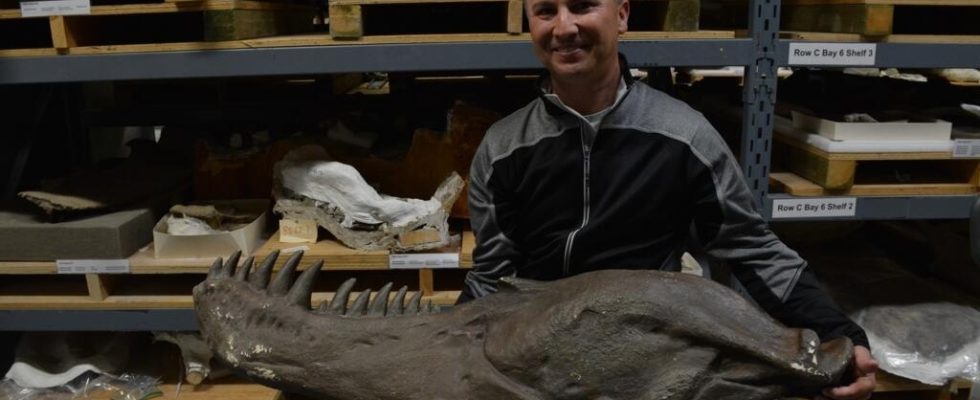François Therrien is a Quebec paleontologist based in Drumheller, in the Canadian province of Alberta, one of the five most famous sites in the world for Cretaceous fossils. This dinosaur enthusiast since childhood joined the Royal Tyrrell Museum around ten years ago to try to go back in time to these extraordinary animals.
From our correspondent in Canada,
To get to the Royal Tyrrell Museum from Calgary, in western Canada, you have to spend more than an hour through grain fields, punctuated by oil wells. Suddenly, the monotony of the landscape is interrupted. A semi-desert landscape opens up to the visitor, canyons stratified with millennia-old gray, white and black layers. A dinosaur lover’s paradise is Drumheller, the area’s big town.
The museum building dedicated to dinosaurs is located away from the city, in a desert area. Dozens of families flock to the main entrance. Head to the museum’s private reserve, where François Therrien, curator of paleoecology at the Royal Tyrrell Museum, arranged to meet us.
In the dusty room, dozens of shelves rise to the ceiling, populated with dinosaur fossils sleeping in their plaster shells. Dressed soberly, jeans and a gray t-shirt, François, 49, jumps from one fossil to another, his eyes shining with the brilliance of enthusiasts.
Childhood dream
Become a paleontologist: study dinosaurs, a period that dates back more than 66 million years and spanned tens of millions of years. A dream for many children, and François was no exception to the rule. “ As a child, I spent a lot of time with my head in books about dinosaurs, I was completely passionate about the subject. The problem was that I was also stubborn “, he laughs. So stubborn that he began studying paleontology in the early 1990s.
These studies are intense, between Montreal and the United States, based on biology, mathematics, geology and even physics. “ I was a very studious student, I really wanted to become a paleontologist, and the places were expensive, but still a little less than today. » Today, with the generation of films Jurassic Parkthe paleontologist admits that it is even more difficult to fit into the environment: “ When getting started in paleontology, it is better to have a plan B, in addition to becoming a researcher. » He playfully admits not having planned a plan B when launching into the field.
François gradually specialized in the study of the climate and the environment of dinosaurs: “ In paleontology, to put it simply, there are those who study the anatomy, the bones of dinosaurs, and those who study their behavior, their habitats, in short, the ecology aspect. » He is carrying out a thesis on environmental conditions at the twilight of the Cretaceous, the last geological era of dinosaurs, in Romania. A choice that will pay off and facilitate his integration into the selective world of paleontology.
A matter of luck and passion
Indeed, after temporary contracts at the Royal Tyrrell Museum, a position opened up in 2006. François’ specialization then particularly interested the institution: he was able to advise it on the setting and postures to give to the dinosaurs on display. He gets the job and makes his dream come true.
Since then, François Therrien has alternated his activities to the rhythm of the seasons. The winter is devoted to fossil analyses, to pure, very academic research. In the summer, he goes out into the field. “ Compared to other Canadian teams or other countries, we are lucky to be based directly on exceptional terrain. : Alberta is a gold mine of fossils », he gets carried away. The researcher even has the luxury of carrying out short missions, sometimes over a day, simply leaving the museum, in the canyons of the region.
It was in the province that he made one of the most incredible discoveries of his career, in 2008. With a team, they dug up an ostrich dinosaur fossil, but this time, something caught his attention. “ On one of the bones, I discovered small black streaks. At first, I thought it was an anomaly, and I jokingly said to my colleagues “imagine if these are traces of feather implantations, like in Asia!” It was later discovered that the specimen was covered in it », remembers the paleontologist, his eyes incandescent. The discovery of this anatomical feature was a first on the American continent.
A paleontologist anchored in his time
For the moment, François intends to continue his research, hoping to contribute to answering the major question of paleontology: what are the precise causes of the extinction of the dinosaurs? There are already solid leads in the field: “ The meteorite was the ax, but climate change didn’t help, and I want to know how much. For now, it seems that dinosaurs resisted temperature variations quite well. »
Alongside research, François popularizes the world of dinosaurs as much as possible. To make people dream, on the one hand, but also to make known a branch of science that is relatively unknown and fantasized by the general public: “ The Jurassic Park and Jurassic World film series really led to a huge boom in the field. Well, the films have some inconsistencies of course, like the fact that a T-Rex wouldn’t see you if you’re standing still. : in your place, I would rather advise you to flee ! »
While some conspiracy theorists question the very existence of dinosaurs, while others say that there is no interest in studying such a distant era, François emphasizes the interest of his science: “To the time of climate change so intense that we are experiencing today,oThere is so much to learn about the environmental and climatic upheavals that these species have experienced. » A way, too, of putting our place on Earth into perspective.
